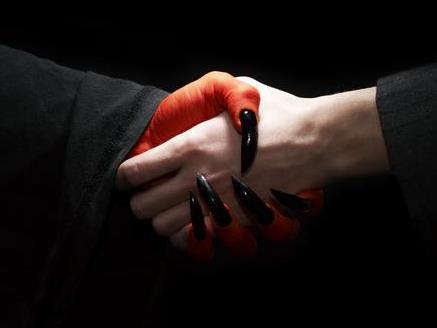Image: via gawker.com
If the role of art is to disturb, not please, as Frie Leysen argued recently on ArtsHub, what happens when arts organisations delve into the pockets of the gambling sector, coal mining corporations or telecommunication companies? Do business partners with problematic agendas dampen the arts’ drive to challenge societal structures and norms, or enable artists to flourish on their dollar?
At the Fifth Public Art Galleries Summit held in Bendigo, Anna Thurgood, Gallery Director, Artspace Mackay explored whether partnerships between galleries and coal mines is a pact with the devil or a match made in heaven.
In 2012, Artspace Mackay commissioned artist Danie Mellor to create two artworks commemorating Mackay’s 150th Anniversary of European settlement. In need of approximately $40,000 to secure the commission, the gallery received support of $20,000 from BMC, BHP Billiton’s coal arm.
This was not without wrestling a moral dilemma. Thurgood admitted she felt like a hypocrite. ‘Sponsorship funds are great, but they are coming from the largest coal miner in the world. And I’m sure that most people who work in art galleries are concerned about environment, like a lot of people are in society, and I know I am … So taking money from them didn’t sit comfortably.’
Despite the ethical dilemma, Thurgood come to the conclusion, ‘You’ve got to do what is good for your community and sort of get over yourself.
‘I have to say with my philosophical dilemma, you should get over yourself, and get over it. If you have access to funding that comes from the profits of mining, the truth is they are looking for organisations or projects to invest in the community, they need to do that, they know their impact on communities is huge and it’s not about me it’s about community.’
Tuning in with your community can be the difference between an enriching partnership for an arts organisation and one that is seen to be tarnished with ‘blood money.’
The severed ties between major sponsor Transfield and the Sydney Biennale as a result of artist-led boycotts is an example of the company’s affairs – in this case the management of offshore asylum seeker detention facilities – being disconnected from the community’s interests.
What one community may accept, another will disapprove, explained Thurgood. In the Upper Hunter Region, the Muswellbrook Regional Arts Centre’s partnership with Rio Tinto Coal Australia is ‘no problem at all because for its community it is a natural fit.’
In 2012, the Arts Centre celebrated its partnership with Rio Tinto with a catalogue and exhibition, 25 years: The Rio Tinto Retrospective.
‘Without the ongoing financial commitment of Rio Tinto Australia the development of the Muswellbrook Shire Art Collection would be a very different and much poorer story. The commitment by Rio Tinto is what attracts the artists, the adjudicators and the public the Prizes year after year,’ said Brad Franks, Arts Centre Manager.
Queensland Gallery of Modern Art also has a long standing relationship with Xstrata Coal Queensland, which in 2013, merged with Glencore, one of the world’s largest global diversified natural resource companies.
Yet for some communities, gallery partnerships with coal companies would be widely contested, ‘I spoke to a regional gallery director who comes from an agricultural area outside of Brisbane and I asked, “Why don’t you try to coal steam gas companies?” and she said “God no, I’d be lynched!” so her community would not accept it.’
So when striking a deal with the ‘devil’, how can you make it work? Determining the communities’ attitudes and needs is integral, as is ensuring there is a shared goal.
The recent announcement of a digital partnership between the National Gallery of Victoria (NGV) and Telstra is an example of working in tandem to empower the community and sector, with Telstra providing infrastructure, technology and financial support to help the NGV reach their ambitions.
Meaningful outcomes are essential to ensure the community benefits from partnerships. For Thurgood, this meant not simply ‘ticking the box’ and instead engaging local artists, schools and delivering workshops.
With set terms and conditions stated in the partnership, creating meaningful outcomes means being specific about what you want and what you can deliver, and negotiation the expectations of the sponsor.
The Artspace Mackay team experienced some strain due to the expectations from sponsor BMC. When providing funding of $20,000, what did they want in return? As it turned out quite a lot, said Thurgood, who explained that the ‘terms and conditions ended up ending up being quite extensive and expensive, cutting into the budget.’
Being mindful of staffing resources and capacity can help during the negation process. When receiving a large sum of funding, it can be easy to fall into ‘yes’ mode and promise too much.
‘If it feels like too much it probably is too much and I would say pull it back if you can, be strong and say you don’t’ have the capacity to deliver that.’
Marketing is a basic requirement of sponsors, and Thurgood recommends doing as much possible, but learned to also ask for them to market you. ‘I think it should be put out there that the project should be marketed by them,’ she said.
In the wake of her philosophical dilemma, Thurgood sees the partnership as a good thing for the artists and community. ‘I am so proud that we were able to get those works that relate specifically to Mackay into our collection as we would never have been able to afford it,’ added Thurgood.
Next time, she might just quadruple the amount requested, highlighting that such corporations have a social responsibility to give back to the community, and why can’t that community be the arts?
‘Go for the whole amount,’ she advised, ‘I would definitely ask for more next time.’




